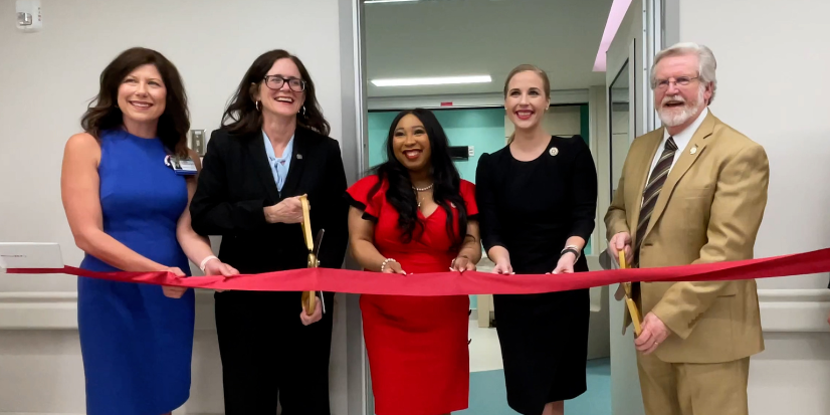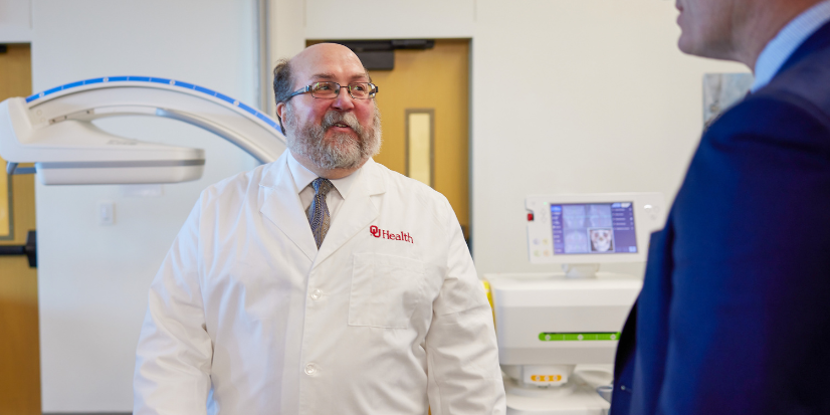COVID-19 and Virus Variants
- Category: Blog, Adults Services
- Posted On:

At a White House briefing last month, Dr. Anthony Fauci, director of the National Institute of Allergy and Infectious Diseases, said the COVID-19 Delta variant is the nation’s greatest threat to date in the pandemic battle. Experts including OU Health Chief Quality Officer and OU Chief COVID Officer Dale Bratzler, D.O., MPH, believe the Delta variant, first identified in India, is responsible for the sustained, upward trend in new cases of COVID-19 in Oklahoma as well as the nation.
Viruses are known for their ability to adapt to environmental change in order to survive and thrive. Tiny changes are often insignificant, but our experience with this coronavirus has not been typical. Many small changes in the original Wuhan coronavirus have occurred since the pandemic began, and it is clear that the pandemic is not over.
According to Dr. Bratzler, we have opposing opportunities: to strongly encourage people to get vaccinated, or possibly to watch a resurgence of infection, severe illness, hospitalization and death.
Why is the Delta Variant Important?
- The Delta variant accounts for more than 50% of new COVID-19 cases now occurring in the U.S.
- It spreads more easily from person to person than the original COVID-19. Studies suggest that it spreads as much 50-60% faster.
- It seems to spread quite readily among children.
- It is likely that the Delta variant will drive outbreaks of COVID-19 in clusters of unvaccinated people. The variant will spread rapidly in those groups.
How are we doing in Oklahoma?
- Oklahoma has a high population incidence of new cases. The seven-day rolling average is around 500 new cases each day (as of July 14). Just a month ago, Oklahoma was tracking 99 new cases per day. Compared to last fall and winter, these numbers are relatively small, but a 4-fold increase in cases per day in just a few weeks is significant.
- Cases aren’t rising as rapidly in central Oklahoma as in other areas. Our major metro areas don’t mirror each other as hot spots. During the week of July12:
- Oklahoma County reported 314 cases (6 cases per 100,000 per day).
- Tulsa County, with a smaller population than Oklahoma County, had 613 cases, (13 cases per 100,000 per day). Adjusted by population, Tulsa County’s cases are two times greater than Oklahoma County’s.
- High rates of case growth in other counties include:
- Ottawa County in far northeast Oklahoma, around Miami, has had the highest rate of new cases per day in the state.
- Craig County, also in northeast Oklahoma, numbers are also quite high.
- Comanche County, which includes Lawton, is experiencing a noticeable increase.
- Hospitalizations across Oklahoma are increasing rapidly and have more than doubled over the past 10 days.
- Oklahoma is not doing a lot of variant testing right now. While a recent report from the Oklahoma State Department of Health confirmed 92 cases of Delta, the numbers are likely much higher. We really don’t know what the numbers are.
- State capacity for greater genomic sequencing is limited. Waste water testing shows definite spikes in northeastern Oklahoma and sequencing is being done on those samples.
Where is the virus spreading?
- Arkansas currently leads the nation with the highest number of new cases and the highest rate of growth in new COVID-19 infections. Missouri currently ranks third with an extensive outbreak of Delta variant cases..
- Arkansas and Missouri are regions where vaccination efforts have slowed or stalled.
- Missouri has done genomic sequencing that confirms the Delta variant accounts for most of these new cases.
- Increased activity in southwestern Missouri and Arkansas is likely driving increasing cases in northeastern Oklahoma. The turnpike is an easy drive where the Delta variant is almost certainly going along for the ride.
Why are cases going up?
- Oklahoma is surrounded by states where cases are much higher (Missouri, Arkansas, Colorado, New Mexico). Case counts are particularly high in Springfield and Joplin, Missouri, where genomic sequencing shows this is the Delta variant. And these cities are only a turnpike drive away.
- Complacency – people have let down their guard. Many no longer wear masks consistently and are less cautious in their social gatherings, physical distancing and how they participate in activities.
- Vaccination hesitancy
- High rates of COVID-19 mirror low rates of vaccination. The pace of vaccination has slowed, which makes more people more vulnerable to infection.
- Only 53% of Oklahomans have had at least one dose. Only 44% have had two doses.
- Many people mistakenly believe that because others have been vaccinated, it affords everyone greater protection. That’s true only when 70 – 80 % of a population is vaccinated. In Oklahoma, less than 50 % are fully vaccinated.
Are the Moderna and Pfizer vaccines effective to protect against the Delta variant?
Currently available vaccines are somewhat less effective against Delta. One dose of vaccine is only 33% effective against the variant. With two doses, 88% efficacy is achieved. People who are fully vaccinated are
- less likely to become infected
- less likely to have severe illness if infected
- less likely to spread the virus to others
- less likely to require hospitalization
- less likely to die
What about natural immunity?
- We know that people who have had previous COVID-19 infections develop some degree of immunity. We don’t know with certainly if it is protective against the Delta variant. We know vaccinated people may be infected by Delta, and still of great concern, too many people are not vaccinated and therefore, have no protection.
- We’re likely to see clusters and outbreaks among unvaccinated people where the Delta variant can spread very rapidly.
Are the symptoms associated with the Delta variant different?
Unlike the original COVID-19 virus, respiratory distress is not the most common symptom. Delta often presents with:
- Unrelenting headache
- Runny nose
- Fever
What are the best mitigation strategies as the virus and its variants continue to spread?
- Vaccination of both adults and children is the most effective and protective measure.
- The right masks, worn properly, are universally effective against the spread of infection. Unvaccinated people are strongly encouraged to wear masked to protect others from possible exposure.
- We must continue to be practical and smart in our behaviors and participation in activities where exposure might occur.
- Watch what’s happening in our local communities and alter activities accordingly. Of interest, a recent study by Rand Corporation used its large administrative data base to look at 2.9 million U.S. families with private insurance. The study suggested that small informal gatherings, particularly children’s birthday parties, seemed to increase the risk of COVID-19 infection substantially. In communities where COVID-19 was active, a birthday was associated with a 31% increase in cases within two weeks of these gatherings.
What do we know about heart inflammation as a potential side effect after the vaccine?
- It has occurred but is rare. The Advisory Committee on Immunization Practices reports that of 300 million doses of vaccine, 323 patients met the case definition for myocarditis, or heart inflammation.
- Most of those recovered quite quickly, within a week. Some were briefly hospitalized. It seems more likely in younger patients, and usually in males. Still, it is considered extremely rare.
- Inflammation is not uncommon with any viral infection so it isn’t surprising that it also may occur with
COVID-19.
How good are vaccines in the immunosuppressed?
- Organ transplant recipients are a unique patient population because of the potent anti-rejection drugs that keep the immune system from attacking the new organ. Studies from Johns Hopkins showed that only 60% of these patients developed antibodies after two doses of vaccine. However, another published study showed that a third dose stimulated a stronger immune response with more antibodies produced.
- There is no formal recommendation at this time for more than two doses. It is likely that specific populations will be identified in which the third dose makes sense to support the immune system.
Should vaccinated people seek a booster?
- There are no publications at this time that clearly identify a benefit from COVID-19 vaccine boosters.
- We don’t know for sure how long immunity will last, but early studies indicate immunity may be long-term.
- Third-dose efficacy has only been demonstrated in immunosuppressed patients, such as organ transplant patients.
- It’s not unusual to see decreasing antibodies in the bloodstream. This does not mean that immunity has been lost. The body has a second immune system, the T-cell system. It is more difficult to measure, but is known to house the body’s long-term “memory” with regard to immunity.



